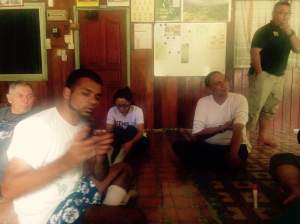To follow on from the work on Monday, relevant groups took part in the first part of field training. Pangolins are habitat generalists, however, as with any species there are certain habitat features that they prefer. In order to maximize success we need to be critically evaluating sites to ensure that release is made as easy as possible for them. Today participants spent a bit of time revising what was already known regarding the ecology and behavior of the pangolin and visited two sites to evaluate which one may be more suitable to release a pangolin at. There are no definitive answers, but there are definitely particular questions that need to be considered which participants were encouraged to think about. By doing this they noticed aspects such as differences in soil type; amount of human activity and availability of sleeping sites.
Conservation strategies and awareness campaigns need to undergo continue monitoring, evaluation and refinement in order to be successful in the long term. Ultimately the place we want to see our efforts have the most impact are in the wild – protecting and in some case boosting numbers.
This is not easy. Pangolins are elusive, solitary creatures and are difficult to find. Traditional methods of camera trapping and night spotting, that tend to work so effectively for other species seem less effective for pangolins. The aim of the workshop was therefore, not to teach participants how to survey for pangolin but get people considering what ecological factors might be important to Sunda pangolin. Is there a higher chance of finding pangolin in one type of forest compared to another? How might morphology and behavior affect where you might place camera traps when searching for pangolin? From what we know about home range size and movement patterns, how far apart should we place cameras and how long should we leave them there for?
However, we also came up with some important strategies and steps that could be implemented immediately. Gathering baseline data is imperative and patterns can be spotted using simple techniques so long as they are regularly repeated.




This is so great. Do you have any course offerings for distance training? I have a few local Maasai in Kenya (2 expert wildlife spotters; one trained in wildlife biology, but not conservation research) that are interested in assisting a very small nonprofit. We recently found out from locals of an area where people are saying “of course” they have seen “many” pangolin. This is highly unusual as most nearby locals have never seen one or have only seen one once in their lifetime. We were considering investing in camera traps, but this sounds like the wrong approach. If you have any pointers or USA/California trainings in May of this year, one of these men will be visiting for other training. I’d also love to find out what info or data is most valuable for pangolin conservation.